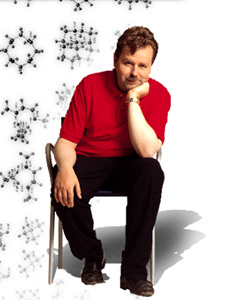Are you a journalist? Please sign up here for our press releases
Subscribe to our monthly newsletter:
"One example of what we are hoping for is the development of a system enablling us to calculate the sapatial structure of a drug than can block the specific receptor. We will than come very close close to the application stage while performing a minimal number of complex and expensive experiments. Computer simulations permit us to 'follow' chemical reactions at the level of the individual molecule in a degree of detail that eludes even the finest experimental techniques of the day."
Dr. Gershom (Jan) Martin Organic Chemistry Department Dr. Gershom Martin holds the Helen and Milton Kimmelman Career Development Chair

A wise man, our sages tell us, is one who can correctly assess future events. Modern chemists are looking to achieve this goal in their attempts to predict the outcome of chemical reactions without performing complicated and expensive experiments. To fulfil such prophetic endeavors, a theoretical chemist, Dr. Gershom (Jan) Martin of the Organic Chemistry Department at the Weizmann Institute constructs computerized simulation systems examining interrelationships between molecules of various materials. Thus, without smoke or odors, at low cost and with maximum safety, tens of thousands of possible chemical reactions can be examined.
Chemical reactions depend on the identity of the participating molecules and their quantum properties, as described by Schroedinger's equation. However, the calculation of the quantum properties of one medium-sized molecule would use up all of the world's existing computer power for about one trillion years. To overcome this stumbling block, Dr. Martin is trying to devise a compromise enabling scientists to achieve as accurate a result as possible while using only a tiny portion of the required effort.
In one case, Dr. Martin helped Institute physicists developing improved radiation detectors to determine the levels of radiation that can be used safely for medical purposes. On the basis of theoretical calculations, Dr.Martin suggested replacing the gas being used in the experiment with another organic gas that would confer greater sensitivity and improved diagnostic accuracy. Thus, seemingly abstract calculations resulted not only in progress in theoretical chemistry but also in a tangible contribution to the field of medicine.